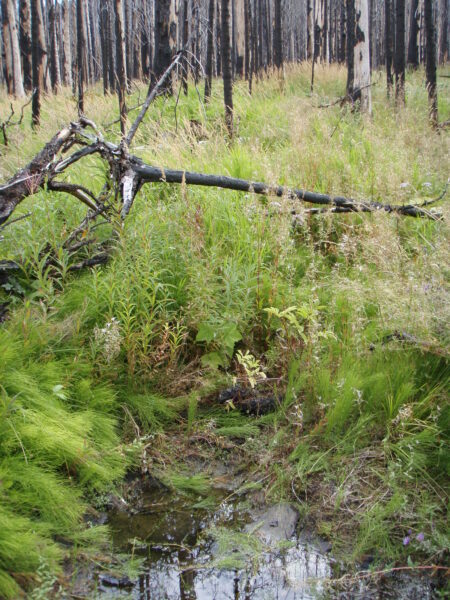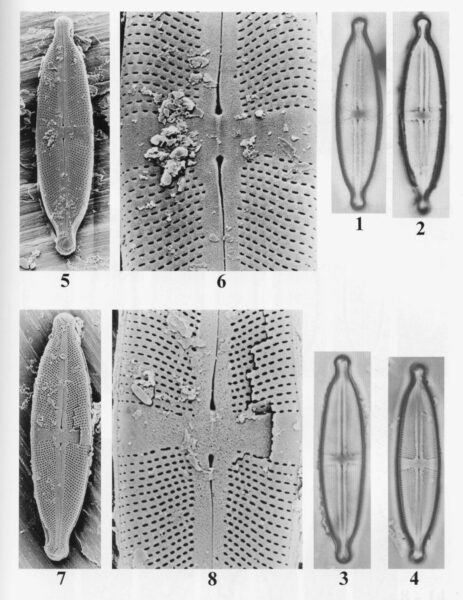Stauroneis reichardtii
-
Category
-
Length Range36-54 µm
-
Width Range8.0-10.8 µm
-
Striae in 10 µm20-26
-
Reported AsStauroneis anceps Sippe 2 (Reichardt 1995)
Stauroneis anceps Sippe 3 (Reichardt 1995)
-
ContributorLoren Bahls - Dec 2011
-
ReviewerMarina Potapova - Mar 2012
Identification
Description
Valves are linear-elliptical to linear-lanceolate with nearly parallel sides and abruptly protracted, distinctly capitate apices. The axial area is narrow and linear, widening slightly near the stauros. The stauros is relatively wide and shaped like a bow tie. Short striae are sometimes present in the stauros. The raphe is lateral, becoming filiform at the center of the valve. The proximal ends are straight and not (or barely) expanded. Striae are radiate in the middle of the valve and strongly radiate near the apices. Areolae are easy to distinguish in LM and number 24-28 in 10 µm.
Autecology
Stauroneis reichardtii has been collected from several lakes, ponds and wetlands in the Northern Rockies. Measured pH at these sites ranges from 6.5 to 7.6 and specific conductance ranges from 21 to 67 µS/cm. Stauroneis reichardtii was described from material collected from Sardinia (Lange-Bertalot et al. 2003) and has also been found in tropical South America. This taxon is widely distributed in the Arctic (Van de Vijver et al. 2004).
-
Size Range, µm3
-
Motility
-
Attachment
-
Habitat
-
Colony
-
Waterbody
- Learn more about this
Original Description
Valves linear-elliptical or linear-lanceolate to elliptical-lanceolate, ends abruptly protracted, i.e. distinctly set off capitate to subcapitate (not rostrate as in St. anceps and St. jarensis comparatively). Length 22-48 µm, breadth 6.2-11.5 µm. Pseudosepta lacking. Raphe fissures moderately lateral with rather inconspicuous central pores (LM). Axial area approximately linear and narrow. Central area forming a moderately to rather broad fascia reaching the margins and here more or less expanded. Striae radiate throughout, less near the central area but more towards the ends, 21-23 in 10 µm. Puncta of the striae very easy to discern, also in LM without oblique lighting (as in St. anceps and St. jarensis, unlike *St. amplipora), 22-25 in 10 µm.
-
AuthorLange-Bert., Cavacini, Tagliaventi, and Alfinito 2003
-
Length Range22-48 µm
-
Width6.2-11.5 µm
-
Striae in 10µm21-23
Citations & Links
Citations
Links
-
North American Diatom Ecological DatabaseNADED ID: 62101
Cite This Page
Bahls, L. (2011). Stauroneis reichardtii. In Diatoms of North America. Retrieved April 25, 2024, from https://diatoms.org/species/stauroneis_reichardtii
Responses
The 15 response plots show an environmental variable (x axis) against the relative abundance (y axis) of Stauroneis reichardtii from all the stream reaches where it was present. Note that the relative abundance scale is the same on each plot. Explanation of each environmental variable and units are as follows:
ELEVATION = stream reach elevation (meters)
STRAHLER = distribution plot of the Strahler Stream Order
SLOPE = stream reach gradient (degrees)
W1_HALL = an index that is a measure of streamside (riparian) human activity that ranges from 0 - 10, with a value of 0 indicating of minimal disturbance to a value of 10 indicating severe disturbance.
PHSTVL = pH measured in a sealed syringe sample (pH units)
log_COND = log concentration of specific conductivity (µS/cm)
log_PTL = log concentration of total phosphorus (µg/L)
log_NO3 = log concentration of nitrate (µeq/L)
log_DOC = log concentration of dissolved organic carbon (mg/L)
log_SIO2 = log concentration of silicon (mg/L)
log_NA = log concentration of sodium (µeq/L)
log_HCO3 = log concentration of the bicarbonate ion (µeq/L)
EMBED = percent of the stream substrate that is embedded by sand and fine sediment
log_TURBIDITY = log of turbidity, a measure of cloudiness of water, in nephelometric turbidity units (NTU).
DISTOT = an index of total human disturbance in the watershed that ranges from 1 - 100, with a value of 0 indicating of minimal disturbance to a value of 100 indicating severe disturbance.

Stauroneis reichardtii
- Valves nearly linear, sides nearly parallel
- Apices capitate
- Stauros shaped like a bow tie
- Proximal raphe ends straight and weakly expanded
Valves are linear-elliptic to linear-lanceolate with nearly parallel sides and abruptly protracted and distinctly capitate apices. The stauros is relatively broad and shaped like a bow tie. The axial area is narrow and linear. The proximal raphe ends are straight and weakly expanded.
 Diatoms of North America
Diatoms of North America









